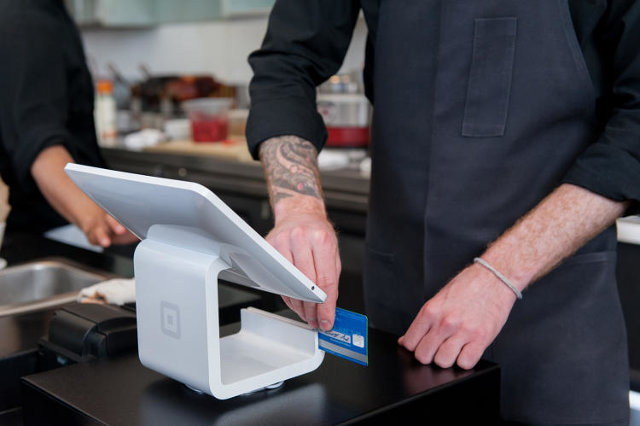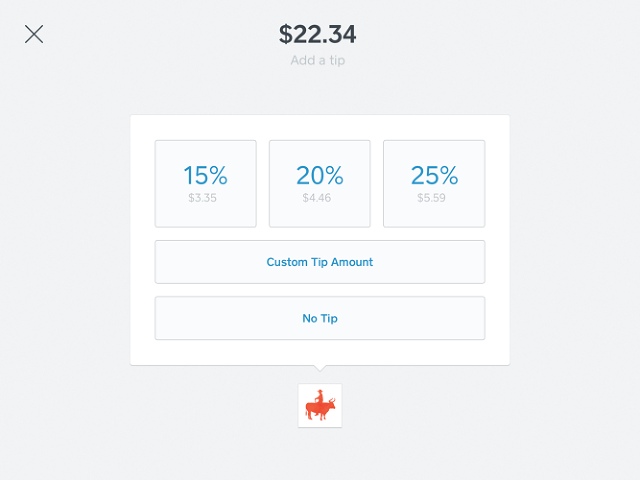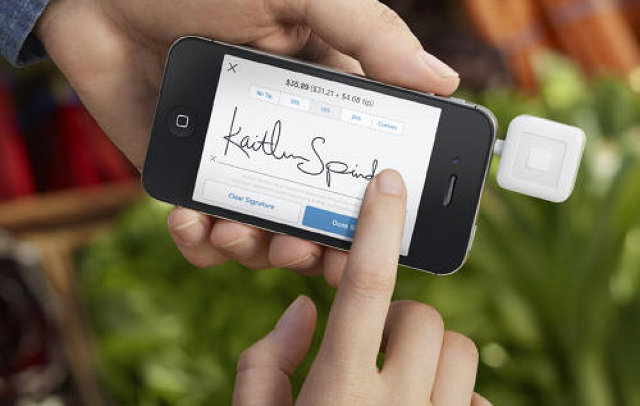How Square Register's UI Guilts You Into Leaving Tips
A few weeks ago, a young couple walked into New York City's popular Big Gay Ice Cream shop and ordered a shake. One of the customers then handed the cashier his credit card, and after swiping it through Square Register, the mobile payments service developed to replace traditional point-of-sales systems and cash registers, the cashier turned her countertop iPad in the direction of the customer, prompting him for a tip. Without hesitation, the customer tapped the 20% button and the couple went on their way.
The exchange is a common one with Square, according to local merchants who use the service. While a 20% tip may not sound otherworldly, the crucial difference here is that Square is facilitating tips at non-traditional venues--ice cream parlors, coffee shops, bakeries--places where tipping 20% (or tipping anything, for that matter) is not terribly common, like it is, say, at a sit-down restaurant. In interviews with Fast Company, cashiers and baristas at a handful of businesses in New York City, San Francisco, and Portland, Oregon, reported noticing an increase in the frequency of customer tips because of Square. It's not just anecdotal. Square's merchant partners generated more than $70 million in cumulative tips last quarter, up 133% year-over-year (the number of new merchants that use Square Register has also increased, but at a slower rate). What's more, of tippable transactions (not all transactions are set to receive tips), nearly half of them resulted in gratuities, an increase from 37% during this same period last year. At this rate, Square is on track to facilitate roughly a quarter billion dollars in annual tips--an outcome of Square Register's customer-centric design, says designer Jerry Knight.

First, a word on how Square works: The company gives merchants access to a basic white card-reader that they can plug into a mobile device like an iPhone or iPad, to accept credit and debit payments from customers. It's used by tens of thousands of merchants--from food trucks to flower shops--and processes more than $15 billion in transactions annually, according to the company. Since launching Square Register in May 2011, the app, which serves as the interface for business owners, has undergone several major overhauls, including one just last month. The redesigns enhanced features such as data analytics and inventory management. But they also worked to push a greater emphasis on tipping. If customers choose not to leave gratuity, they'll actively have to select the 'no tip' option.
Tipping size (and design) matters The key to the experience is the interaction between the merchant and customer through Square Register. When cashiers accept payments via Square, it's typical for them to swivel their iPad toward the customer, who completes the transaction. On screen, Square might ask for confirmation of the payment, a signature, and a tip, usually in the amount of 15%, 20%, or 25% (or a flat rate rounded up to the nearest dollar). It's this last step that's most significant--an intimate and direct prompt to the consumer. If customers choose not to leave gratuity, they'll actively have to select the "no tip" option.

Because of this design, one cashier in New York City, who asked not to be identified, tells me that he's now seeing "much higher tips." With cash, he explains, customers rarely tip, and if they do, it's usually for no more than a dollar per transaction. With credit card transactions on traditional point-of-sale systems, he continues, customers usually just sign the paper receipt without leaving gratuity. Amanda Ventresca, a coffee trainer at Café Grumpy in New York who has been selling coffee for more than a decade, agrees. "Before, it was easier to avoid tipping--with the old system, you could get away with it because you didn't have to fill out [the paper receipt], though some people would put a dollar in the jar," she says. "But Square puts [tipping] in their face as an option, and although we're not necessarily busier, tips have gone up."
One coffee shop, which asked not to be named, shared that it has seen tips shoot up an impressive $20 or more per eight-hour shift since adopting Square Register--effectively doubling the amount of tips received daily by many of the store's employees. It's potentially obnoxious, because we're saying, 'Here, give me a tip.'
Guilt tipping To Knight, the Square Register designer, the success merchants are seeing is a sign that the system is working. "With this interface, it's really natural to leave a tip: It's very easy and frictionless, so we're seeing a tremendous uptick [in tips]," he says. "It's much more upfront [on Square Register] to leave a tip. The downside to this is that we've had feedback from merchants that feel it's potentially a little obnoxious, because we're saying, 'Here, give me a tip.'"
Ashton Goggans, marketing director at Sightglass Coffee in San Francisco, jokingly refers to this experience as "the guilt move." He says that "the number of tips [at Sightglass] has definitely increased" because of Square, though not the tip size (the average cumulative tip rate on Square is 16% to 17%). He chalks it up to the slightly awkward interaction that Square Register's design forces. "There's a certain amount of pressure, whether it's from the barista in front of you or from the people in line behind you who are seeing you hit the button that says 'no tip,'" he says.

Square didn't always generate more tips for merchants. At Café Grumpy, one of Square's first clients, Ventresca recalls how the first design of Square Register yielded few tips. "When it first came out, the tip option was this tiny little thing at the bottom of where you signed, and absolutely no one was tipping--it was horrible," she says. "They changed it and made it this huge option that almost makes you feel guilty, which is awesome."
Knight says the company has experimented with a range of designs, including one iteration where the customer tipping option was even more blunt. But his team found there was a limit to its impact. "We played around with making the tip [feature] more in the face of the customer, to see how it would sway the numbers, and we're finding that it doesn't really change tipping behavior," Knight says.
As for the guilt leveled on the customer during the process, Knight acknowledges that it plays a role in the transaction. He laughs and adds, "We'll take it where we can get it."
But Knight says the service is more designed for speed and ease of use than guilt tripping (or perhaps guilt tipping). Some merchants using traditional POS systems have turned off the requirement for customers to sign credit card receipts--thus removing the cashier's possibility of earning a tip unless customers decide to give cash--simply because the process is too slow: waiting for the receipt to print, looking for a pen, waiting for the customer to fill it out, waiting for it to be returned to the cashier. "There's a tension between the owners wanting to get everyone through the line and the baristas wanting to get tips," Knight says. Square, on the other hand, is fast and helps mitigate the discomfort caused by having to calculate the appropriate tip percentage on the spot. (With Square Wallet, the startup's mobile wallet service, users can even add a tip after the fact via smartphone.)
One owner of a multi-location business, who asked not to be named, estimates company-wide tips have increased between 40% to 45% because of Square's UI. "Customers seem to really like the ability to make choices in an interface that is so familiar," the merchant says. "Making it easier for customers to make round-dollar amount tipping choices has been huge in changing our [employee] tips."
Knight compares the streamlined experience to the upgraded payment systems in New York City taxis. Before, when cabbies only accepted cash, tips averaged just 10%. But when the city added touch-screen devices to the cab and began accepting cards, the average tip shot up to 22%, reportedly boosting annual tips by $144 million. Why? Because the user interface presented the passenger with three default tip options: 20%, 25%, or 30%. Though users had the option of entering a custom, potentially lower tip amount, it appears few did. "The buttons are really key--it's so much easier than typing in all those numbers," Knight says. "It was a usability problem [before]."
Leftover change(s) Still, the success stories with Square Register aren't universal. At some locations, at least anecdotally, cashiers said that they hadn't noticed much difference in tips with Square, though they imagined the system wasn't hurting. At other locations, some merchants are using Square no differently than they might a traditional POS system: They accept payments via Square but don't require customers to complete their own transaction or prompt them with the option to tip. At Xe May Sandwhich Shop in the East Village, for example, the cashiers use an iPhone to process credit purchases on Square, but they don't put the device directly in the hands of customers and ask them for a tip. The reason? "Our volume is so high and [our turnover is] so fast that it's hard for us to give everyone the iPhone," a cashier explains.A certain je ne sais quoi is lost in the digital tipping experience.
And despite its rapid growth, Square still has a low market share in the POS space. According to one report, Americans tip members of the U.S. food industry about $42 billion annually, a figure that dwarfs the amount of tips that Square processes. But again, the key here is that Square is delivering tips to venues where tips are not universally expected as they are at restaurants.
Ashton Goggans, of Sightglass Coffee, who generally praises Square, also points out that a certain je ne sais quoi is lost in the digital tipping experience. There's some measure of warmth now missing: the delightful jingle of coins crashing at the bottom of a tip jar; the friendly smiles exchanged when a dollar tip or more is given in cash; the satisfaction of saying "keep the change."
But Goggans says he's seeing some interesting behavioral changes with Square Register, too. For instance, he's started to see some people pay with Square but leave a cash tip ("which I always thought was strange"). In some cases, the customers will even select the tip amount but leave the transaction incomplete, so when the cashier turns the iPad register back around, it will display how much the customer intended to tip. It's the modern-day equivalent of George Costanza in the pizza shop on Seinfeld, tipping only for the sake of wanting recognition for his generosity. "I don't know whether that's on purpose," Goggans says. "But it is pretty common."
0 comments:
Post a Comment